Time to Reflect Reality
by Bull.Miletic
"It's the rails. It is the people who laid the rails, who perhaps died years ago, who are still steering the tram."
Lars Saabye Christensen, Echoes of the City, p. 73.
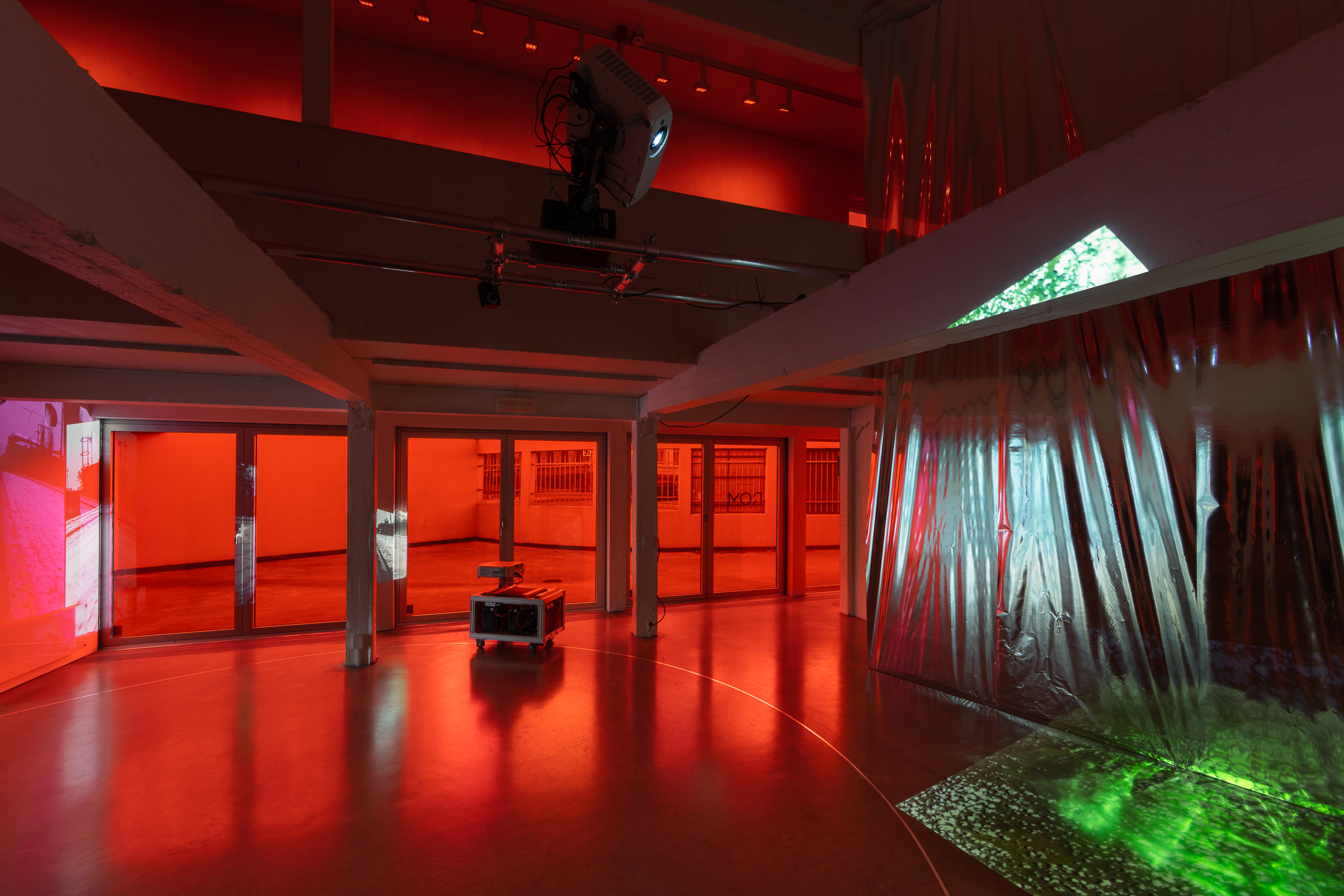
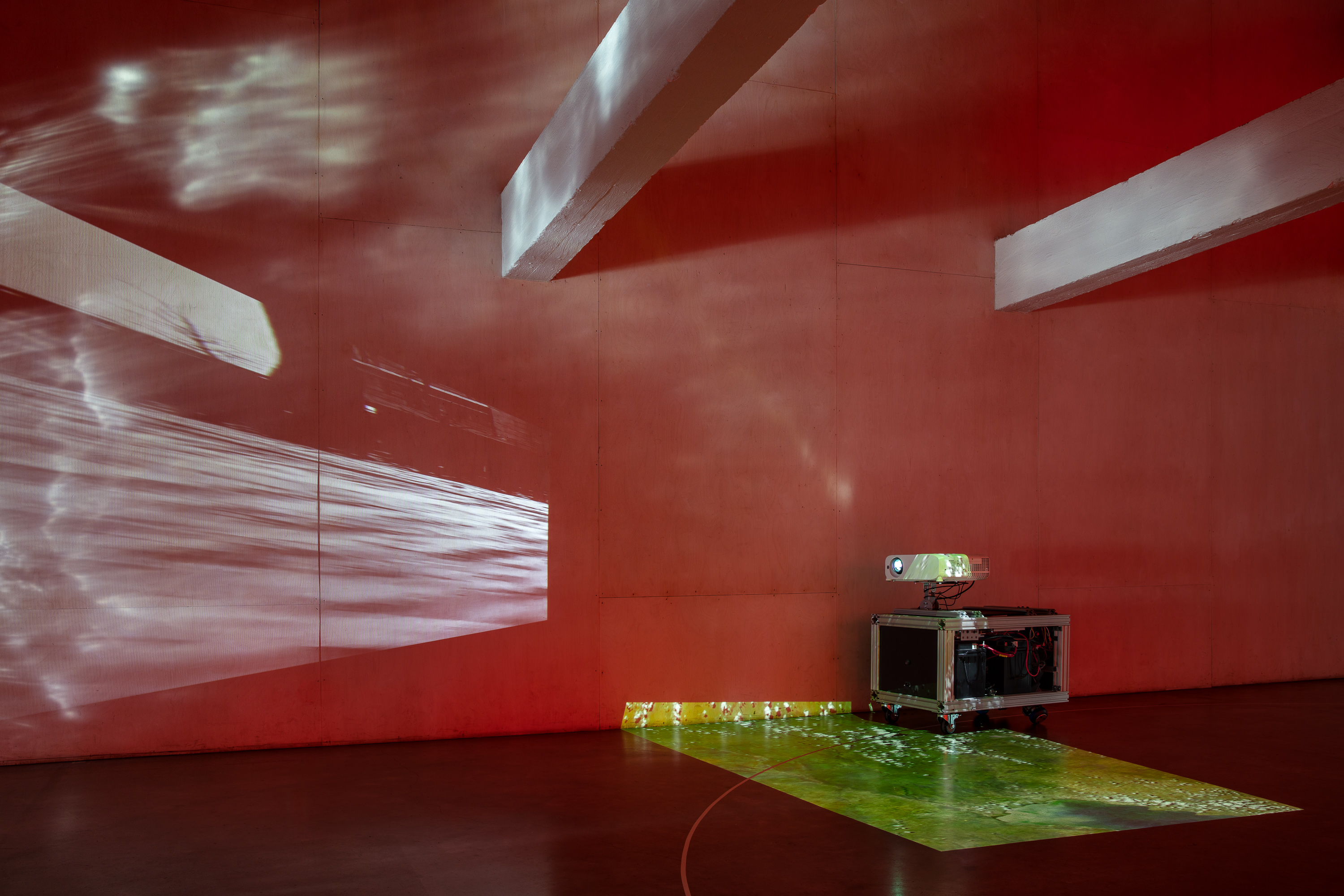
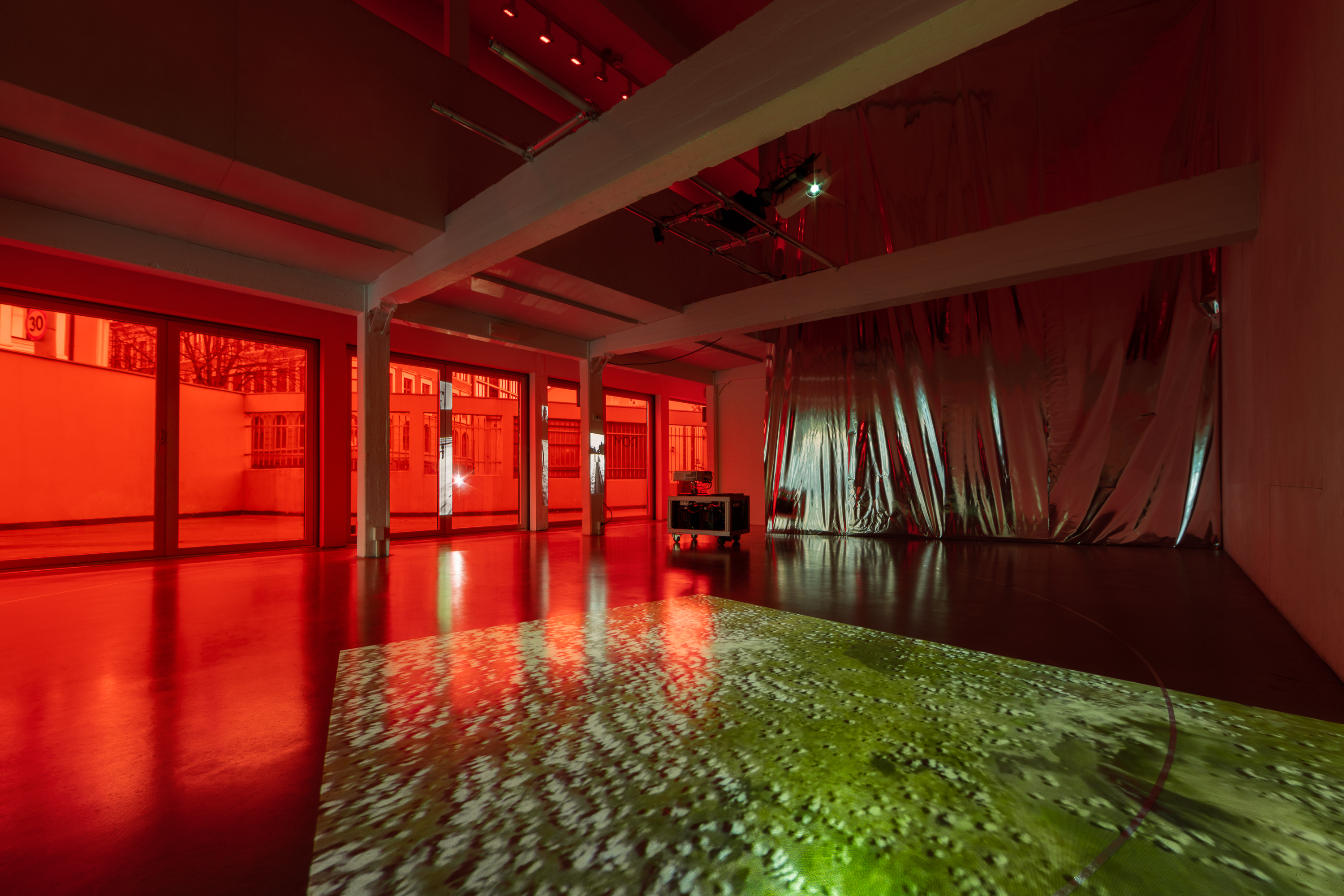
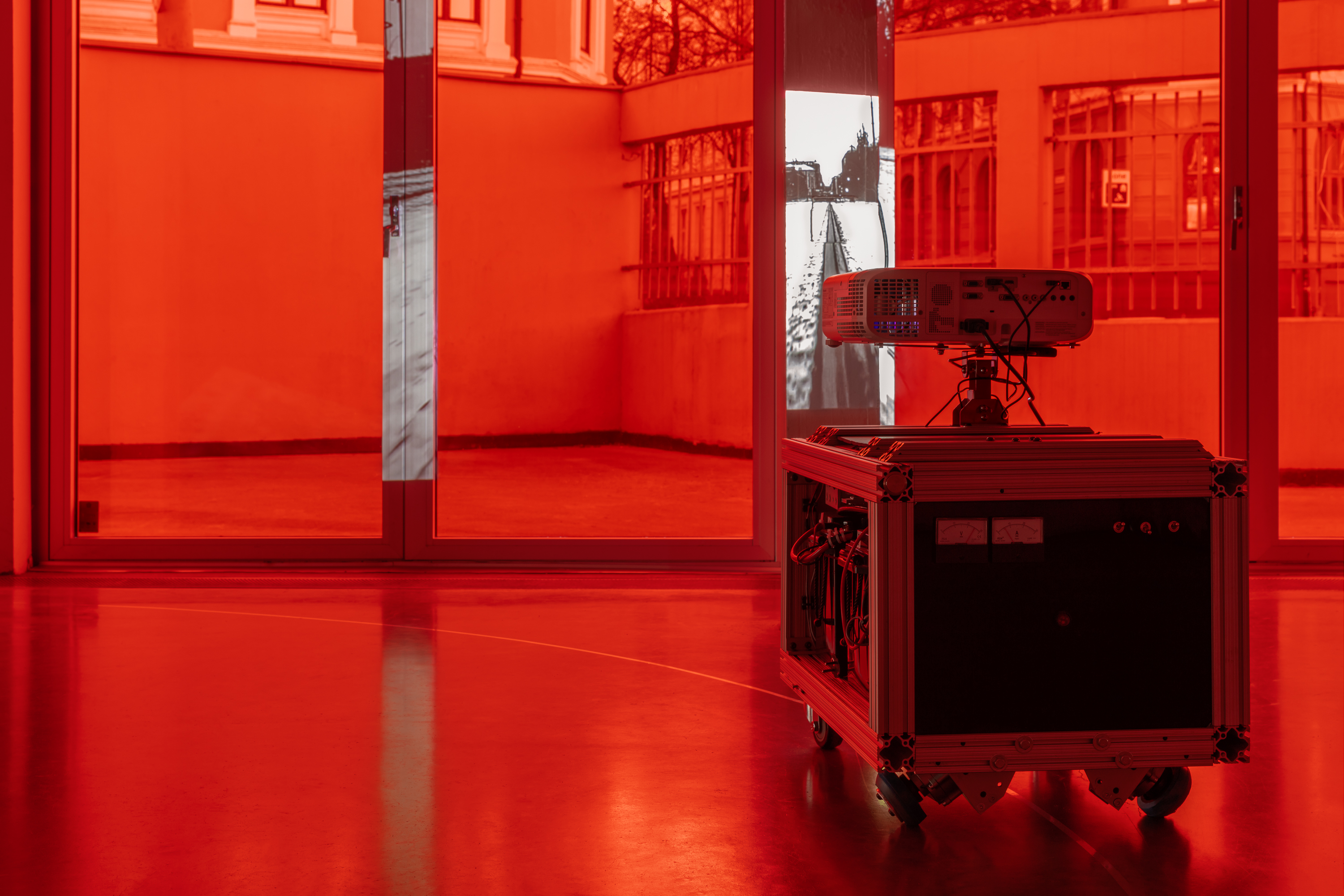
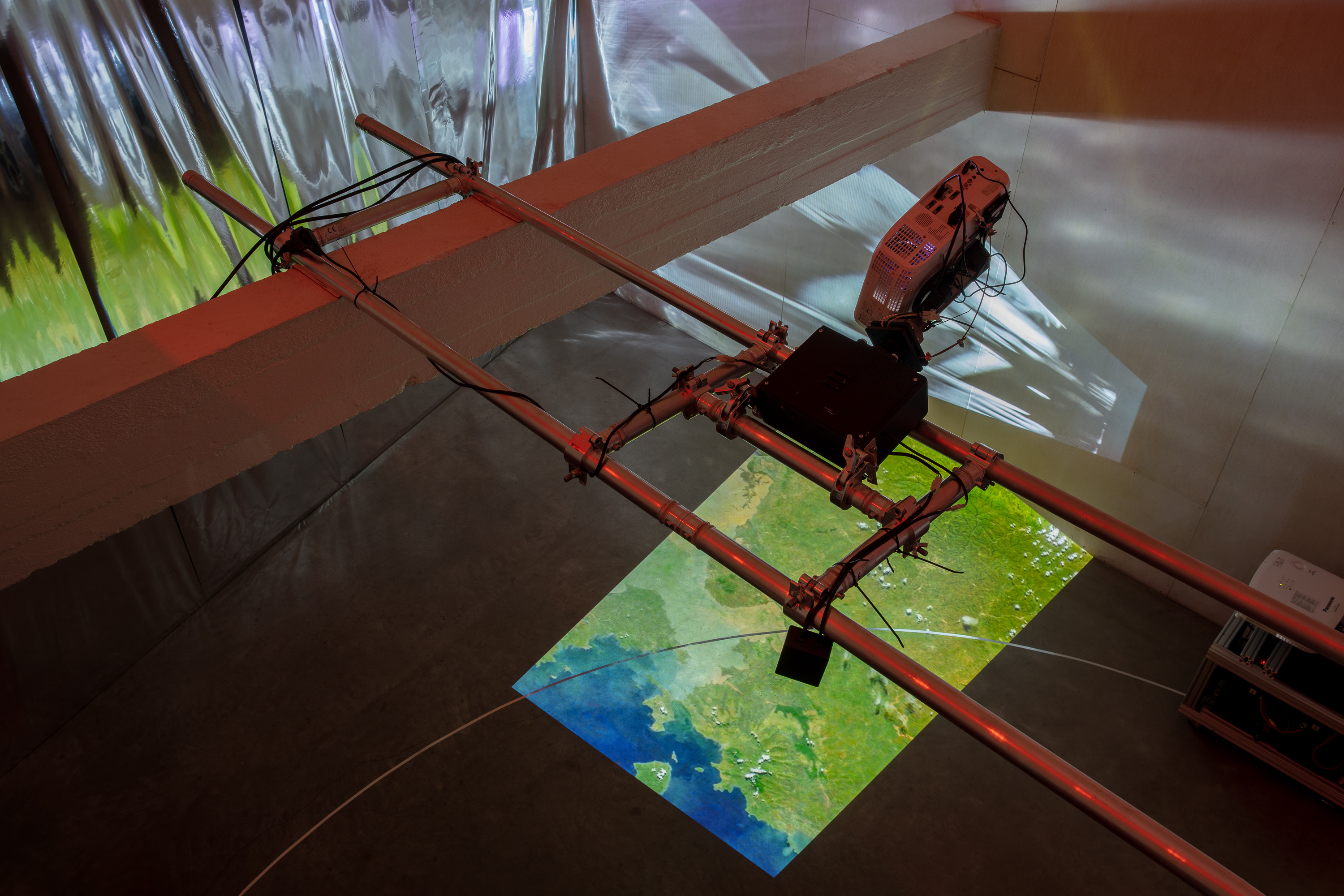
Time to Reflect Reality examines different forms of urban knowledge through a media archeological perspective on machine vision.
The video installation is comprised of two kinetic video projections, a Mylar curtain, and red-tinted windows. One video projector is attached to a slow-moving self-driving vehicle and shows a combination of early cinema phantom rides taken from trams in Trondheim, Bergen, and Oslo in the period from 1908 to 1950 and today's Oslo. These are so-called phantom rides, i.e., footage where the camera is attached to the front of the tram while it traverses the city's network of rails. The other video projector is attached to a slowly rotating mechanism that causes the video image to travel in a 360-vertical loop across the exhibition space. This video shows the recording of the Earth’s surface from the perspective of a NASA satellite in orbit around the planet.
The work addresses the current race to build real-time digital geographies for self-driving vehicles in the future smart city. The time it takes for the system to produce this contextual high-definition map for the self-driving vehicle is referred to as Time to Reflect Reality (TTRR). In this project, however, we are less interested in the concept and future functions of the self-driving vehicle and more concerned with how the advances in machine vision will change our conception of the physical world.
The installation is set up to produce alternative cartographies in the exhibition space through a combination of old and new technologies. Here, we further research and combine the two phenomena we call cinéma trouvé and proxistance. Our intention is to develop a more-than-human approach to knowledge that already figures in the urban environment, but which can easily be overlooked and forgotten in the future smart city.
The self-driving vehicle in Time to Reflect Reality has been developed in collaboration with Chris Myers at the CITRIS Invention Lab, University of California, Berkeley, and Tønnes Frostad Nygaard at the Department of Informatics, University of Oslo.
Cinéma trouvé station
Screening program by Bull.Miletic
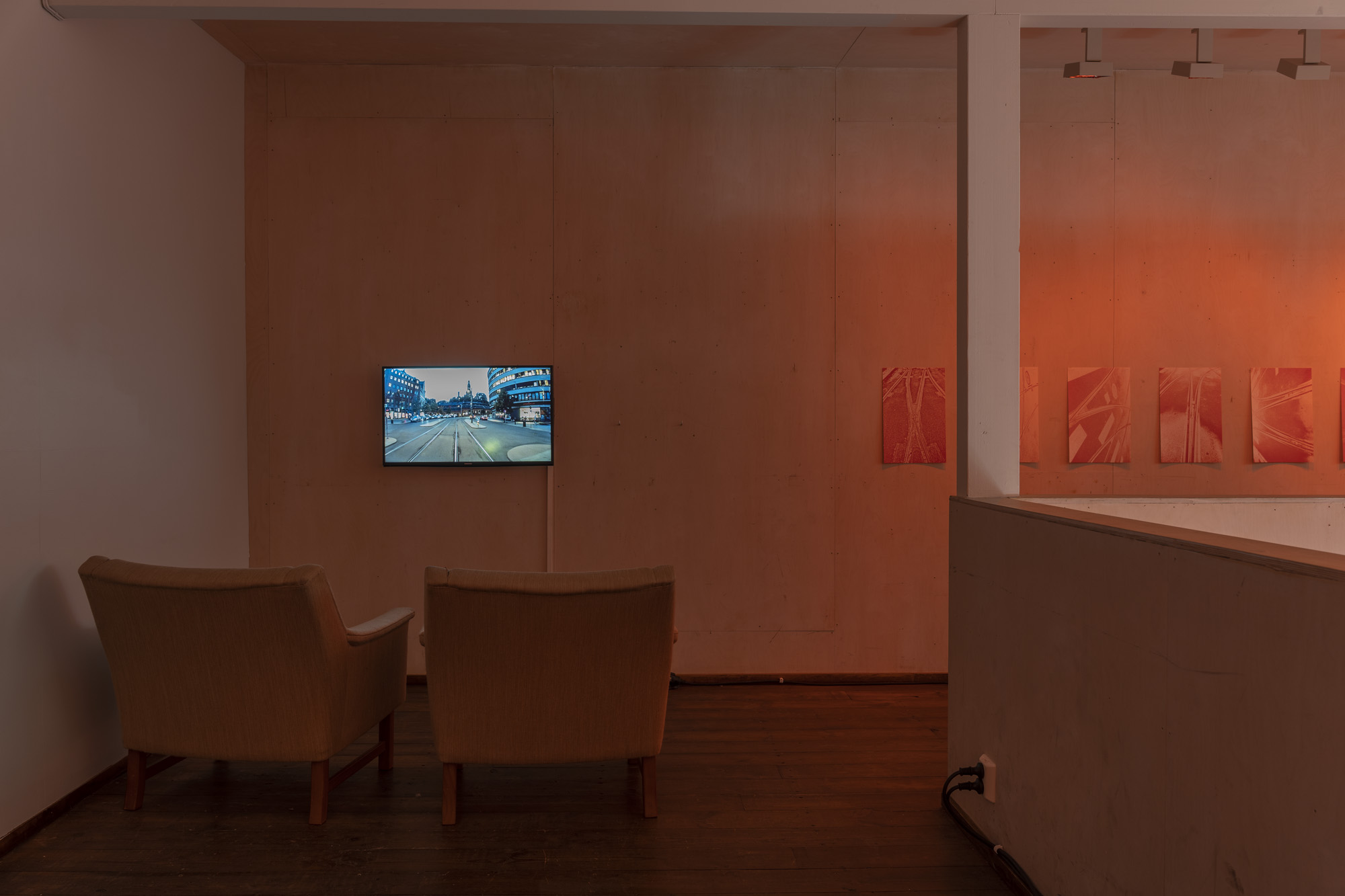
Cinéma trouvé station is a screening program of phantom rides curated by Bull.Miletic. The program serves as reference material for Time to Reflect Reality. The films in the program are courtesy of The National Library of Norway and citizen scientists. The program is open for submissions! Please email the link to your phantom ride to studio [æt] bull.miletic.info
- Trondheim (1949-1950), The National Library of Norway, 0:14 min.
- Oslo (2019), Ciel Waagenes Udbjørg, 8:24 min.
- Oslo (1950), The National Library of Norway, 1:07 min.
- Oslo (2019), Ciel Waagenes Udbjørg, 13:29 min.
- Oslo (1950), The National Library of Norway, 0:35 min.
- Oslo (2020), Ciel Waagenes Udbjørg, 35:07 min.
- Oslo (1950), The National Library of Norway, 0:02 min.
- Oslo (2020), Ciel Waagenes Udbjørg, 8:00 min.
- Bergen (1929), The National Library of Norway, 0:06 min.
- Oslo (2020), Ciel Waagenes Udbjørg, 11:59 min.
- Bergen (1929), The National Library of Norway, 1:09 min.
- Oslo (2020), Ciel Waagenes Udbjørg, 10:08 min.
- Bergen (1929), The National Library of Norway, 0:31 min.
- Oslo (2020), Ciel Waagenes Udbjørg, 11:42 min.
- Bergen (1929), The National Library of Norway, 0:06 min.
- Oslo (2020), Ciel Waagenes Udbjørg, 3:12 min.
- Trondheim (1908), The National Library of Norway, 4:04 min.
- Oslo (2020), Ciel Waagenes Udbjørg, 12:16 min.
- Oslo (1920), The National Library of Norway, 1:14 min.
Hum of the Tram—H.O.T.T. Revisited
by Siri Austeen
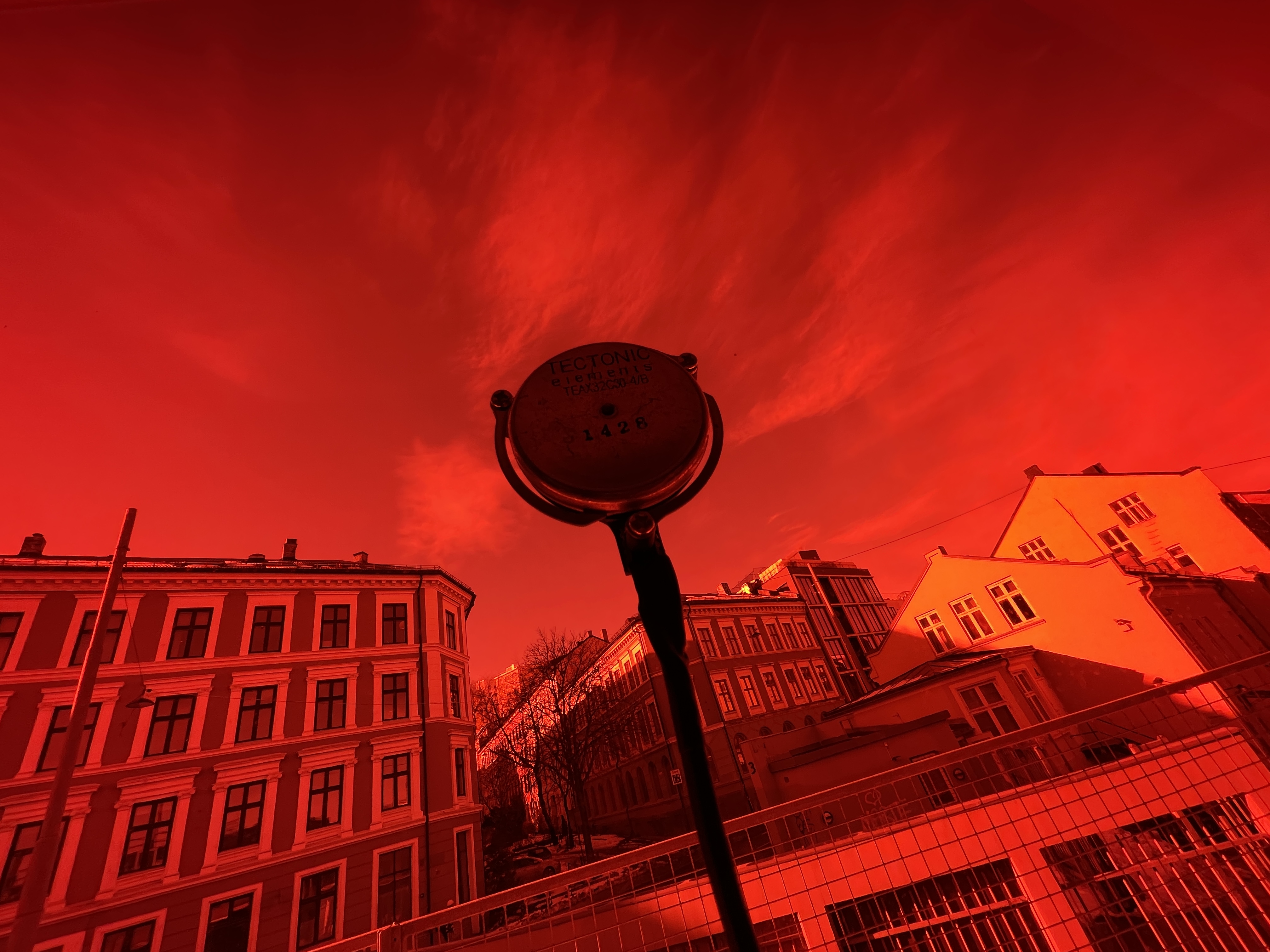
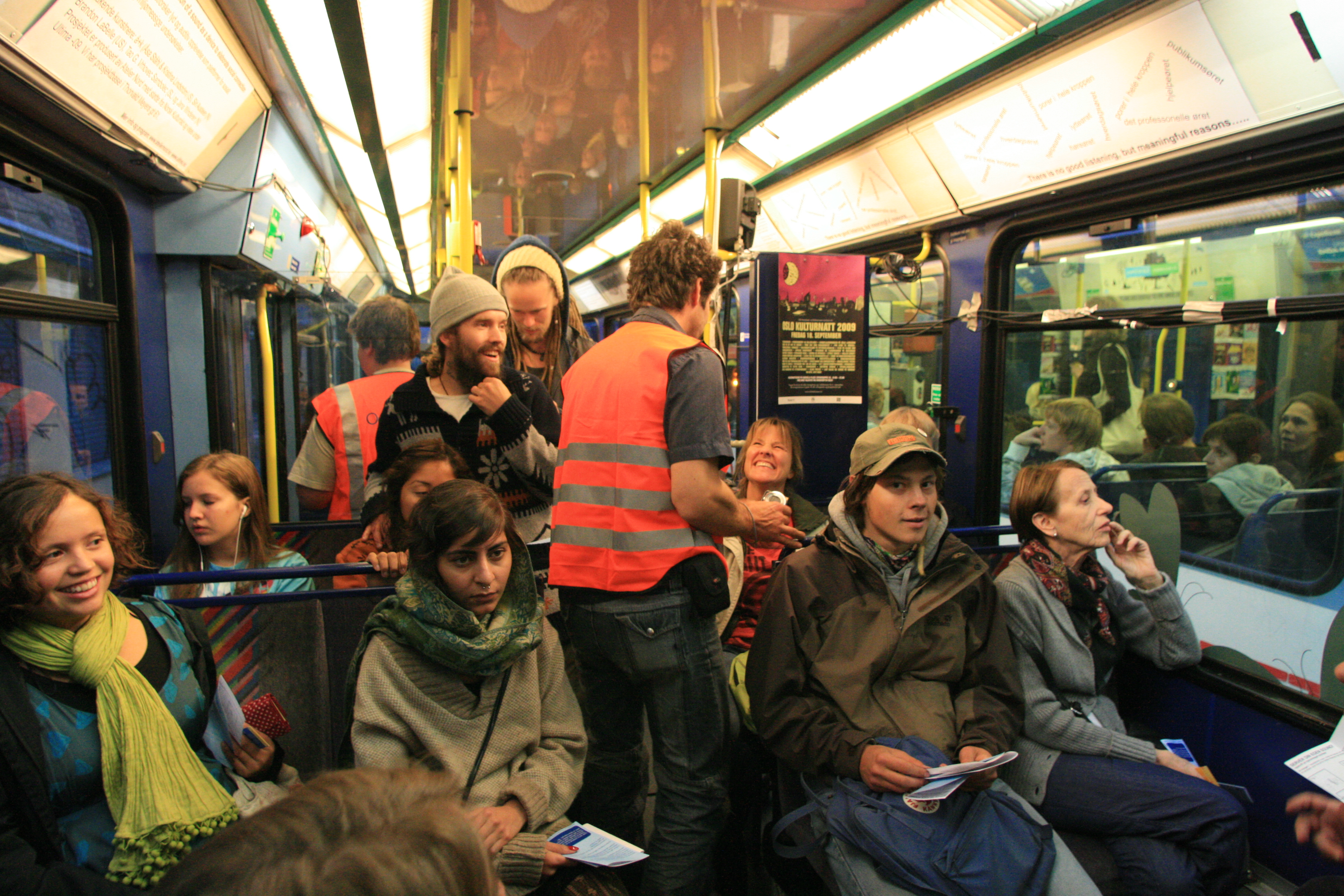
The sound installation Hum of the Tram—H.O.T.T. Revisited, is a relistening of the sound from tram 137, which recontextualizes the project Hum of the Tram in dialog with Bull.Miletic's artistic research project Time to Reflect Reality. The installation refers to the city as an acoustic landscape—and to its hidden yet sensorial audible dimensions. As perspectives of listening and sonic memories of the city are explored, the installation also approaches the gallery space itself as a sound-creating and resonant acoustic object.
The project Hum of the Tram (2009) focused on our common sonic everyday life and how sound can be used both as a medium for social interaction and as a starting point for studies of urban space. The public and travelers were invited on a trip through Oslo with an on-board tram from Olaf Ryes Plass via Aker pier, Majorstuen and back to Sinsen. Using a wide range of recording techniques and a multi-channel playback setup, the sound of the tram's movements was amplified and mixed in real-time. Together with dedicated printed matter and the driver's announcements along the way, the tram was explored as a sound instrument and arena for collective and individual experiences along the way.
Hum of the Tram was part of the project "Manual for the construction of a sound as a device to elaborate social connection" organized by Brandon LaBelle / Jana Winderen for Ultima 2009. Conductor: Leif Inge Xi, mix: Ingar Hunsgaard and Siri Austeen.
The Potential of Language as an Artistic Framework
by Ana Brotas
Ana Brotas presents some aspects of her language-based research developed during the MFA in Art and Public Space at the Oslo National Academy of the Arts. Drawing parallels with the thematics investigated by Urban Ecologies, Brotas looks at the potential of language as an artistic framework.
Urban Biology after Cybernetics: Neurons / Brain / Sponge
“Urban Biology after Cybernetics: Neurons / Brain / Sponge” will be a book chapter in the forthcoming anthology Urban Ecologies.
In the early 1960s, architect and urban planner Constantinos Doxiadis envisioned the city of the future to be “a continuous network of centres.” In order to explain and validate this urban schema, Doxiadis pointed towards the biological logic of neurons—in opposition to the centralized logic of a growing tree. Architect Kenzo Tange envisioned the city as an extended brain: “Large metropolitan areas or megalopolises in our day are becoming the brains for the body of modern society. Whirling around in these brains are the people, and the information. The citizens are like electrons flowing in an electronic ‘brain.’”
Throughout the 20th Century, the city has often been described by referring to biological metaphors: the city as a human body, as a tree, as tissue, or a nervous system. Yet in the 1960s, the equations between a city and a brain were founded on a very specific branch of biology: the biological metaphors of the city as an extended brain were grounded in a branch of biology closely linked with cybernetic theory and advanced computer technology.
Biologist Conrad Hal Waddington (1905 – 1975) was a pioneer of such new developments and his ground-breaking theory of epigenetics laid critical foundations for the field of systems biology. Waddington has been labelled a “Marxist biologist” and in the 1960s and 70s he worked closely with Doxiadis and Tange to conceptually redefine the urban system grounded in his biological theories. His proposition for an urban metaphor was not, however, a cybernetic brain—but a sponge.
Focusing on Waddington’s biological urbanism, this chapter revisits the biological landscape of the urban tissue of the 1960s and shows how Waddington’s urban biology transgressed conventional cybernetic theories of the city as an extended brain. Instead of an open-ended cybernetic network system, the Marxist biologist suggested that cities needed to be planned, built, and developed as solid structures in combination with a soft and flexible tissue—like a sponge with its dense but porous skeleton. For Waddington, the city was not a planetary city of free-floating information as in an electronic brain, the city as sponge was a contingent city, but at the same time fixed and conditioned by particular topographies. Only this urban schema, Waddington claimed, could contain seeds for new beginnings.
RE FLUX
by Christine Petersen + Jonas Gunerius Larsen
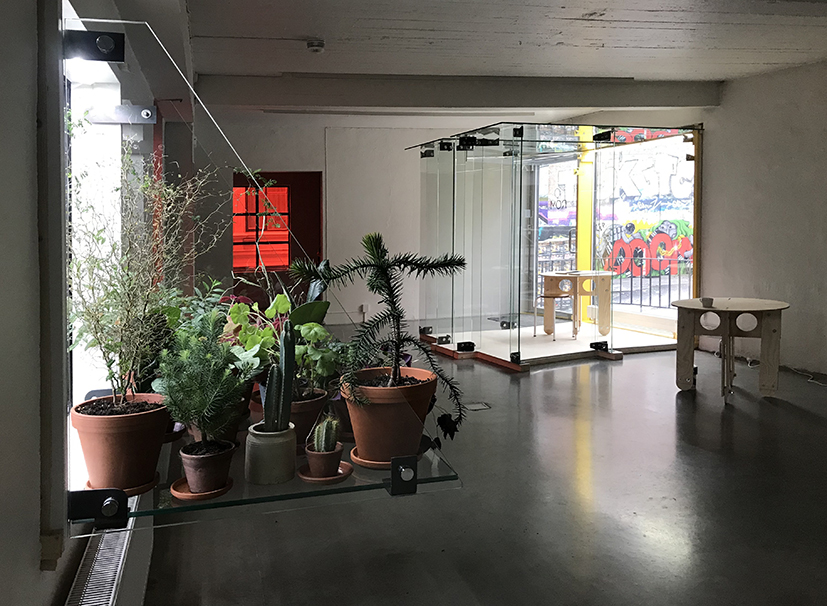
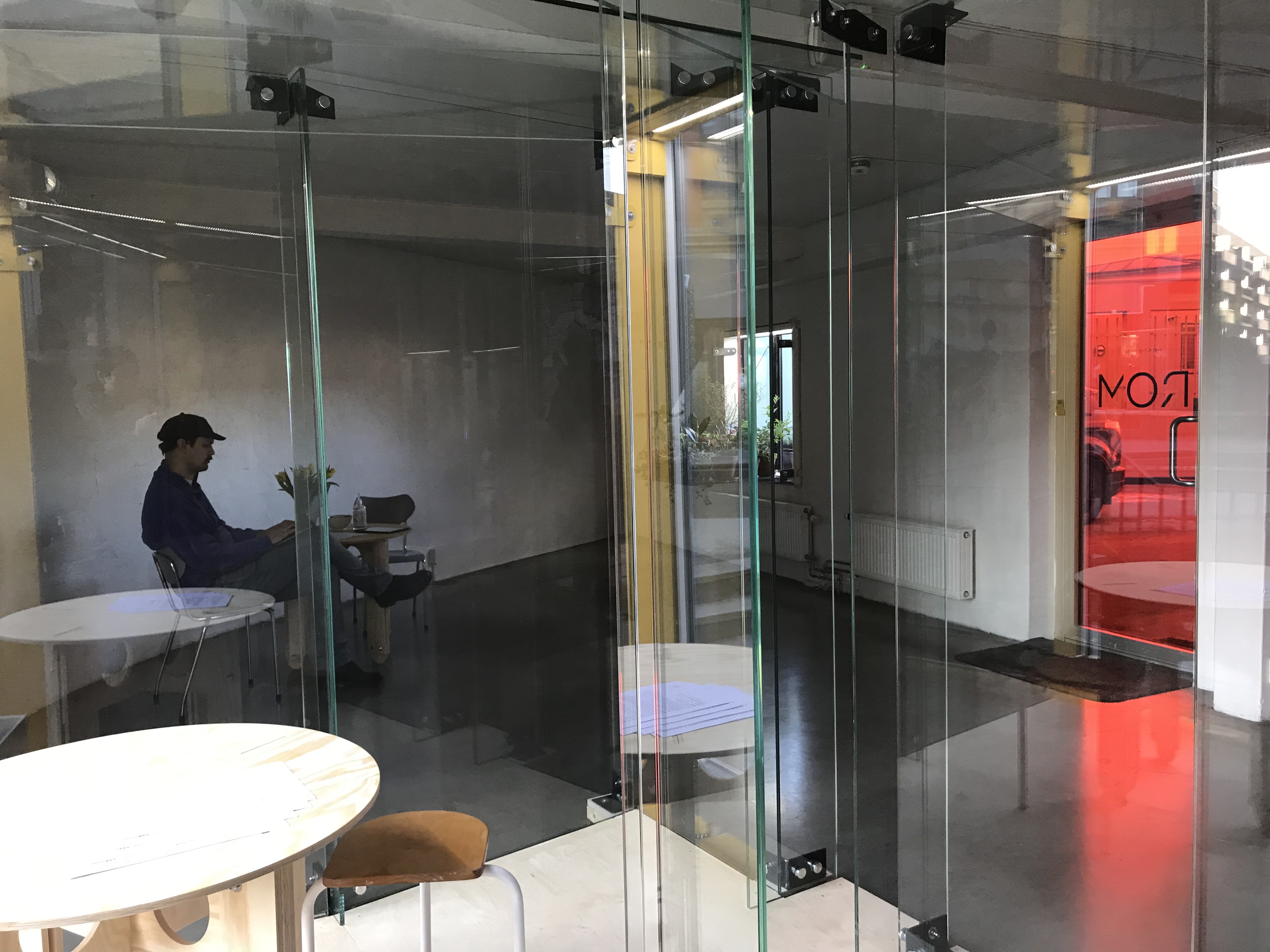
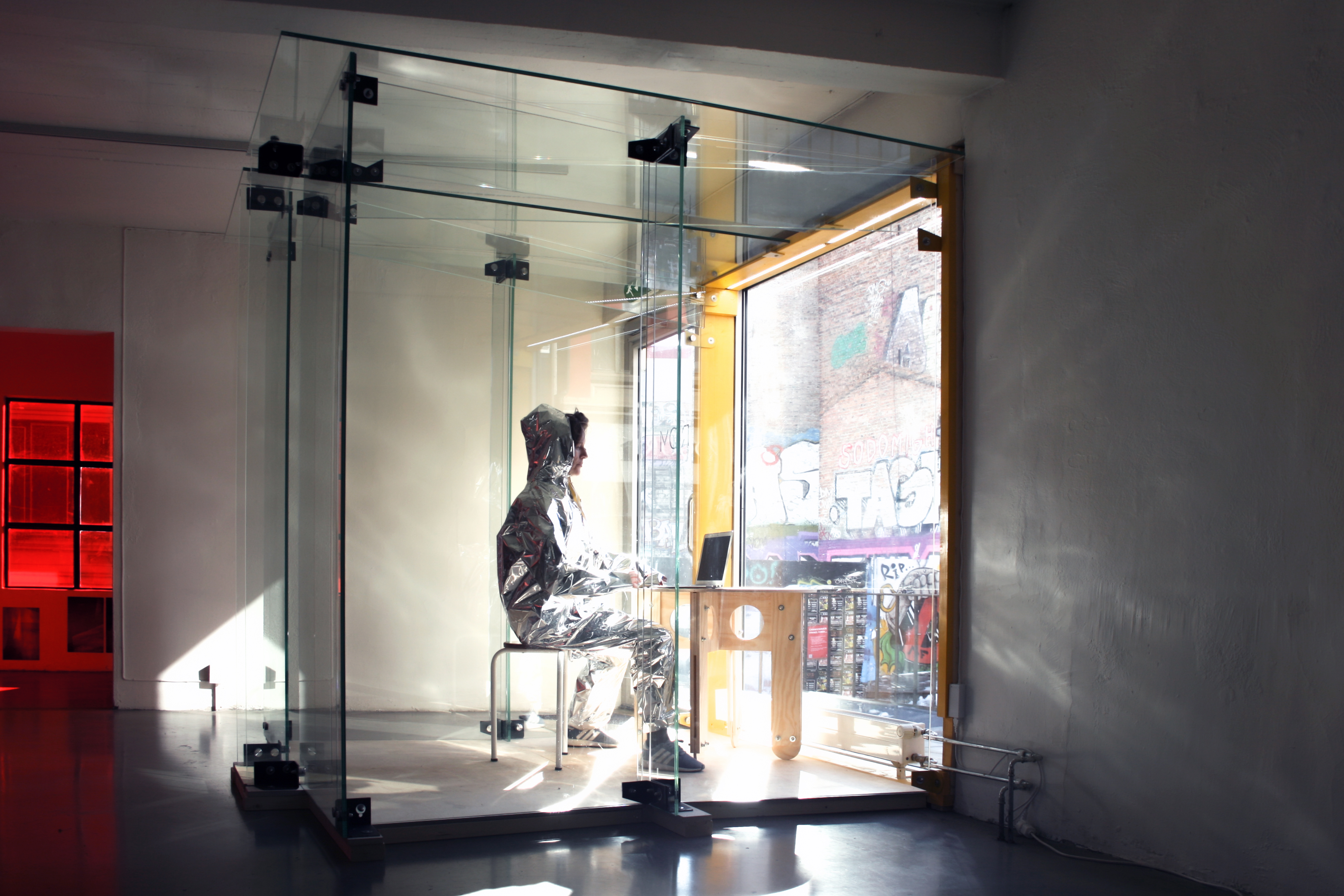
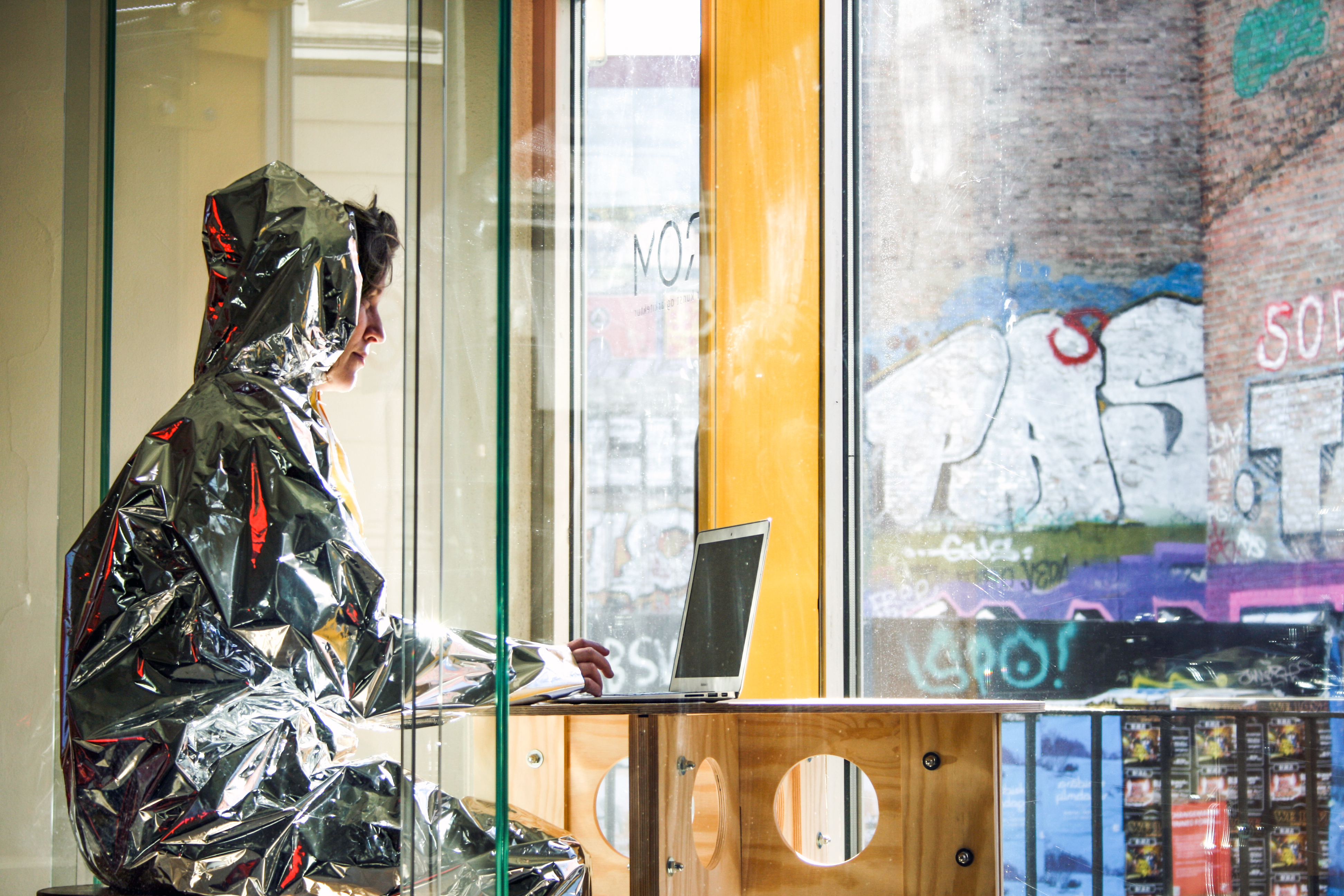
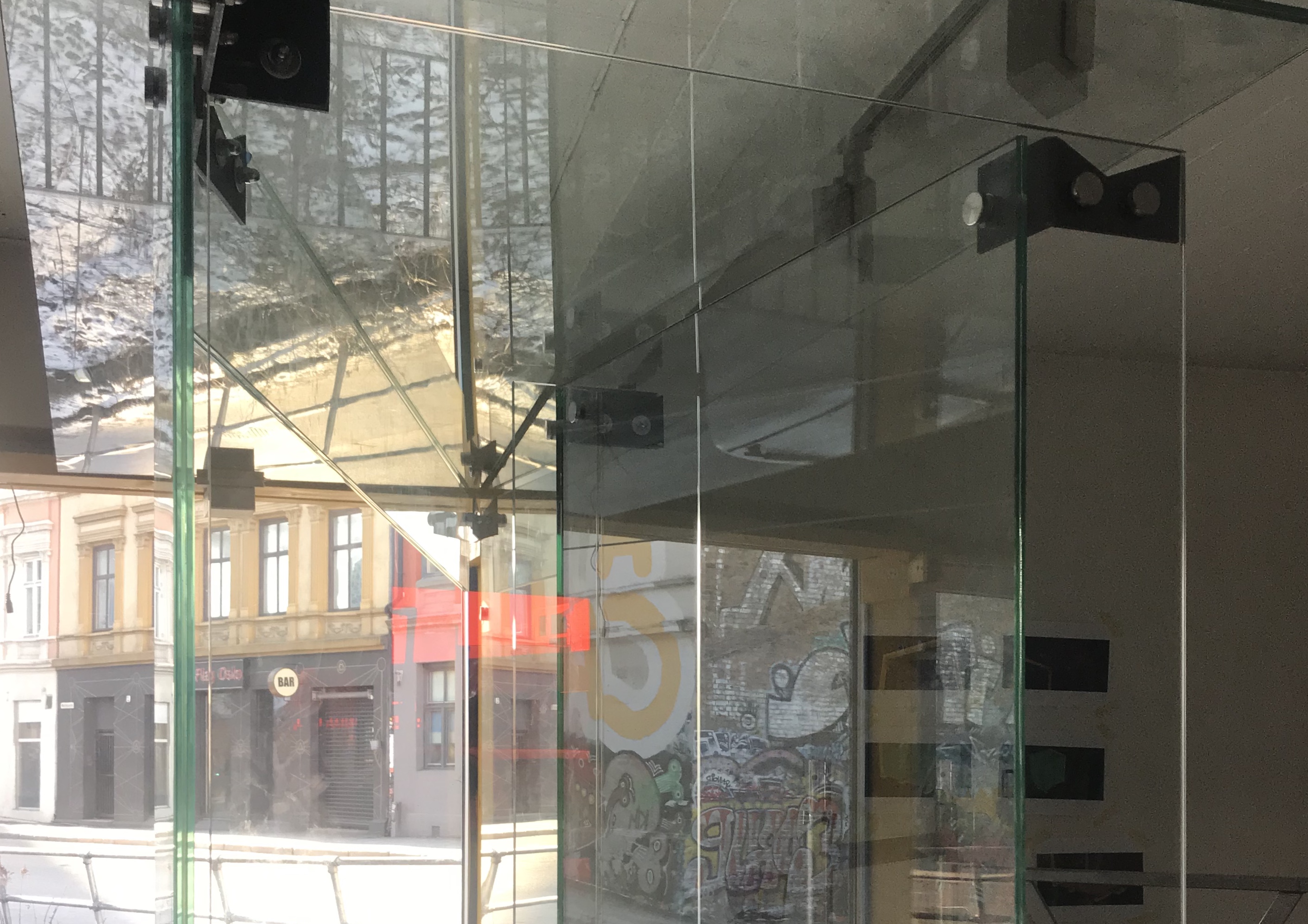
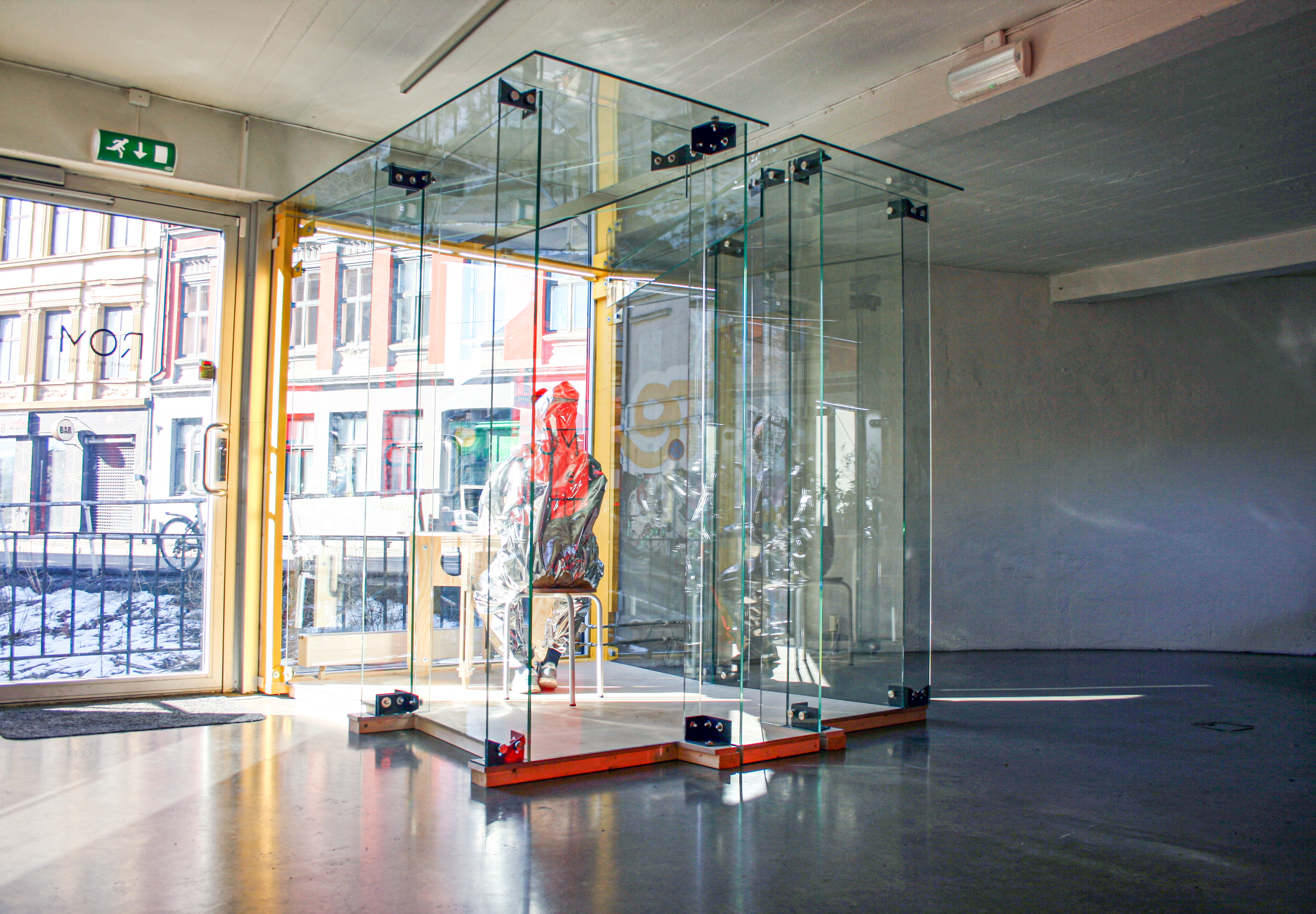
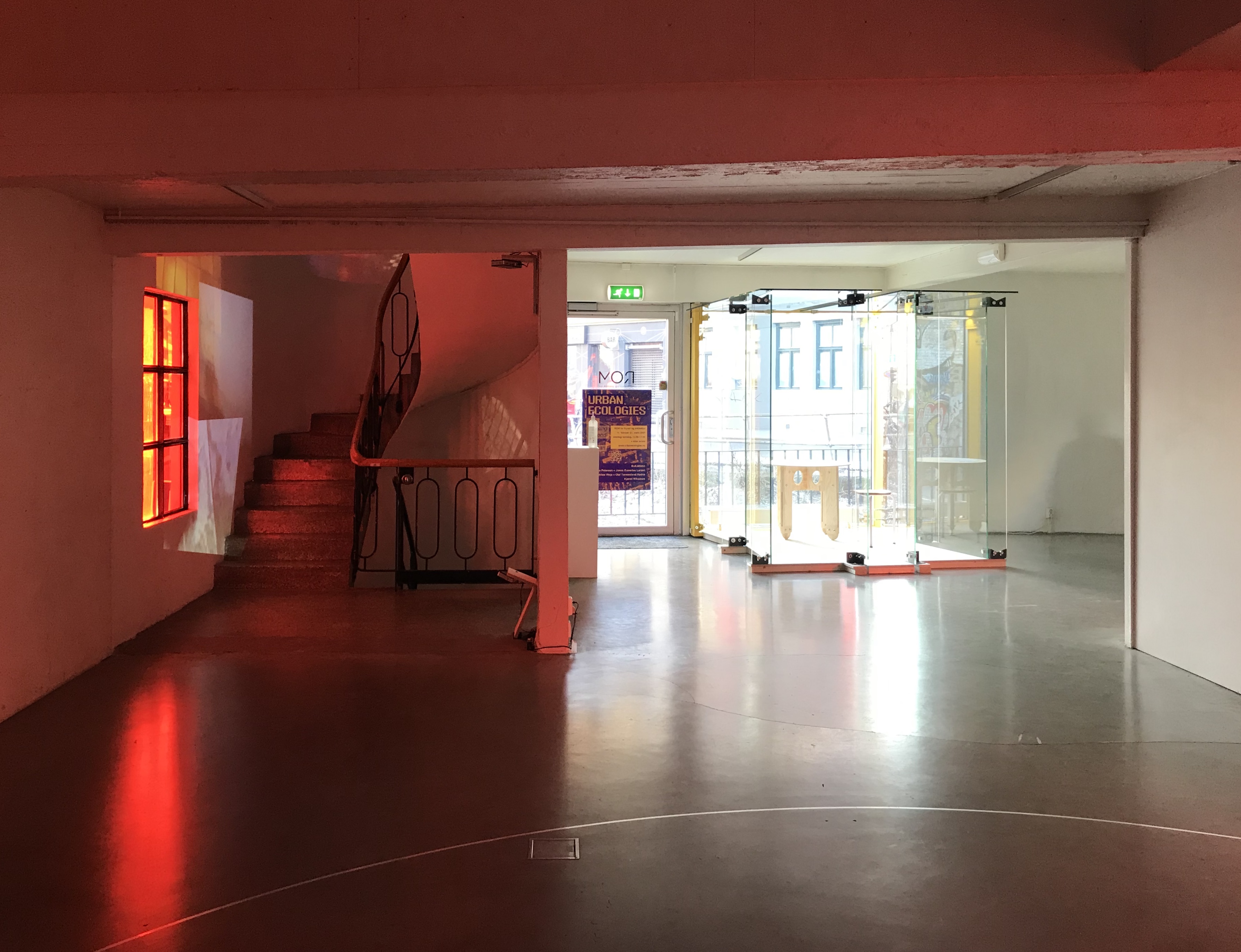
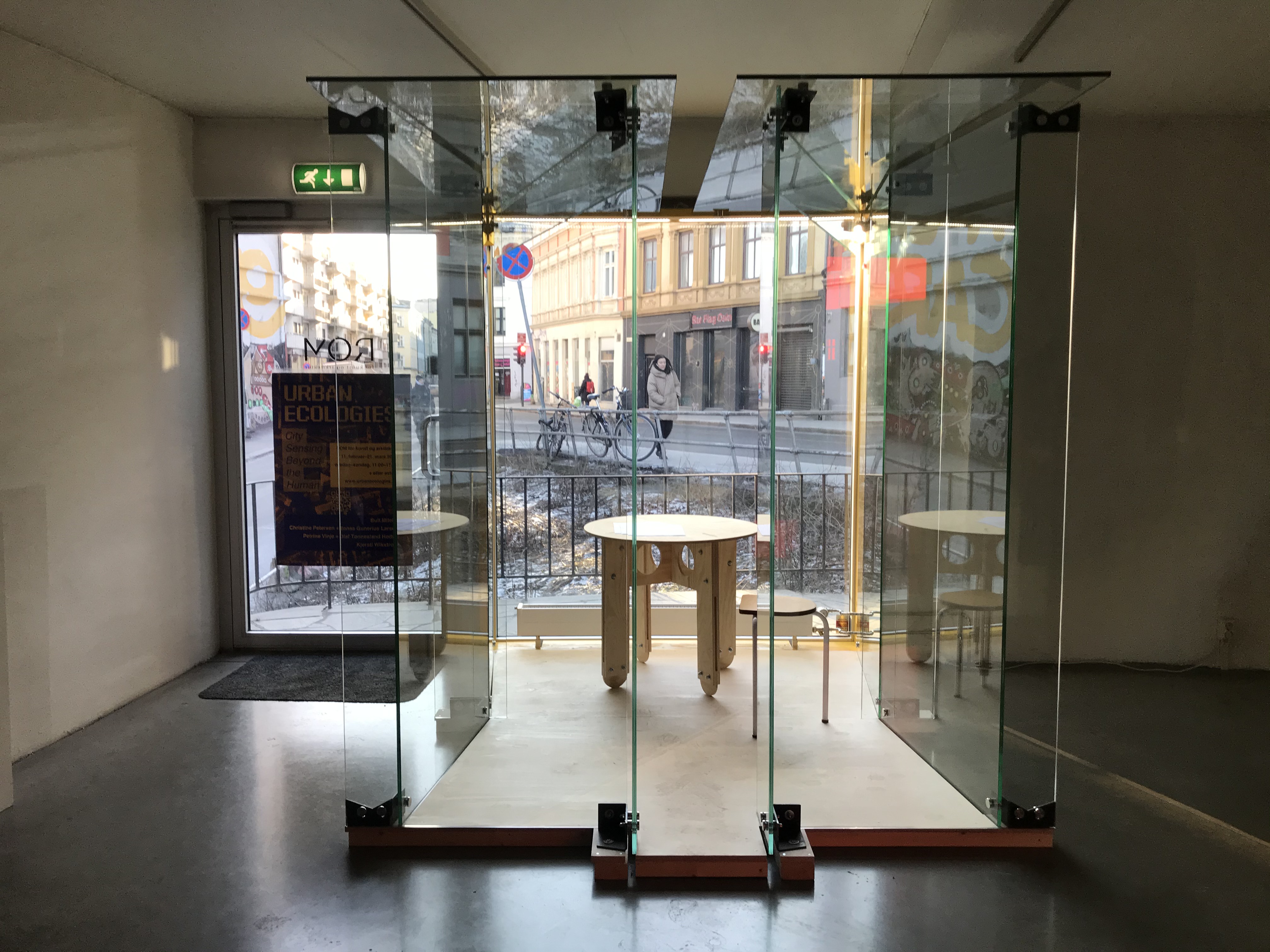
Glass can do so much, and is almost incomprehensible in its nature as it originates from the sand. Imagine that something that is dense becomes transparent. Imagine that something that disappears between the fingers suddenly becomes firm and sharp like a knife. The material can do the ultimate architectural trick; to define space without hindering visual paths or obstructing light.
Physically, the glass forms the facades of the growing city, and figuratively the glass is an apt metaphor for modernity. Smart use of glass has not only given us the opportunity to see the city and thus experience it in a new way, the glass has also allowed us to look into microscopes and out into the universe.
When it comes to ecology and urban development - or the problematization around growth and population - the discussion is often limited to how technology should save us by applying new techniques into buildings. But in the project Urban Ecologies, the concept of ecology is rather understood as a way of understanding the city: different contexts, wholes and cycles.
How can we live ever closer in the city, but at the same time separated? How can we preserve the need for daylight when we have to build closer and higher? RE FLUX investigates how glass can both delimit and open up. What degree of boundaries and sense of space can the transparent create?
RE FLUX consists of two spatial installations in glass that are situation-specific to ROM for Art and Architecture. Both rooms connect to the gallery's existing window openings and thus spread daylight further into the room. A small room connects to the window to the west and a smaller object on the window to the east. Each of the installations has its specific program, which springs from the location in the gallery room. The rooms are not intended as autonomous installations, nor as groundbreaking works within glass constructions. These are rooms that directly relate to the functions of the gallery.
RE FLUX examines the relationship between place, space and light to highlight the importance of glass for how the city is perceived.
Objective Enactive
by Petrine Vinje + Olaf Tønnesland Hodne
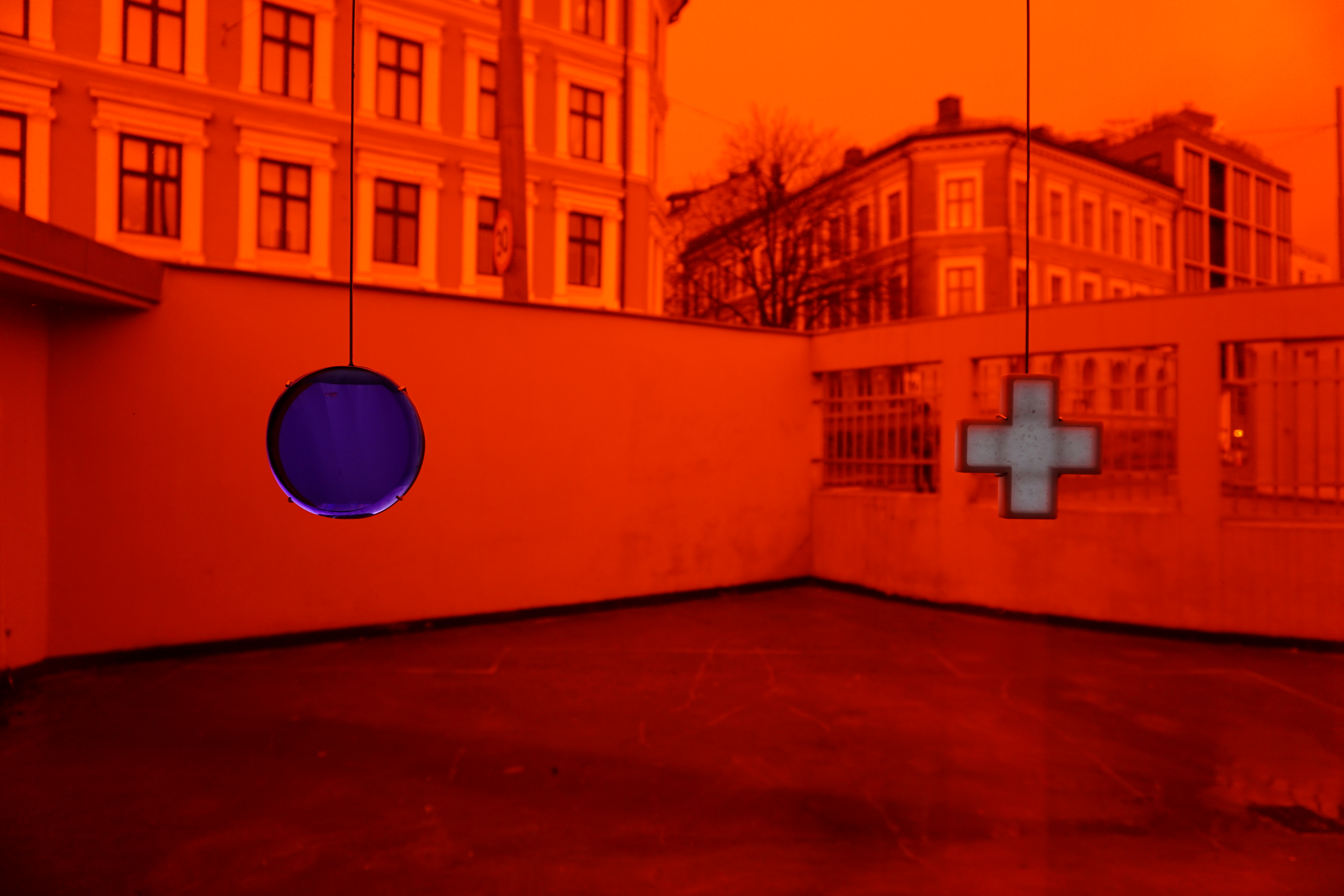
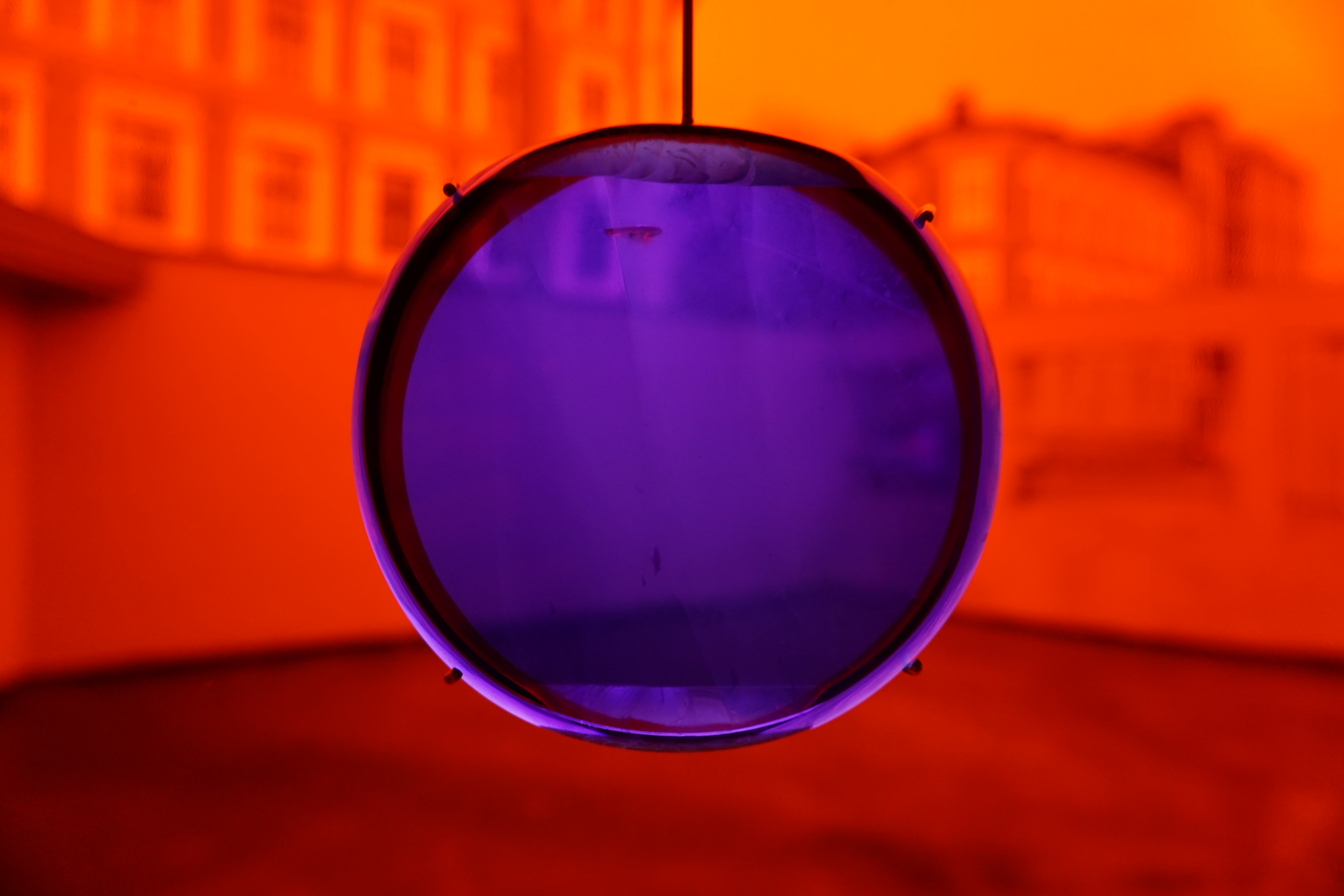
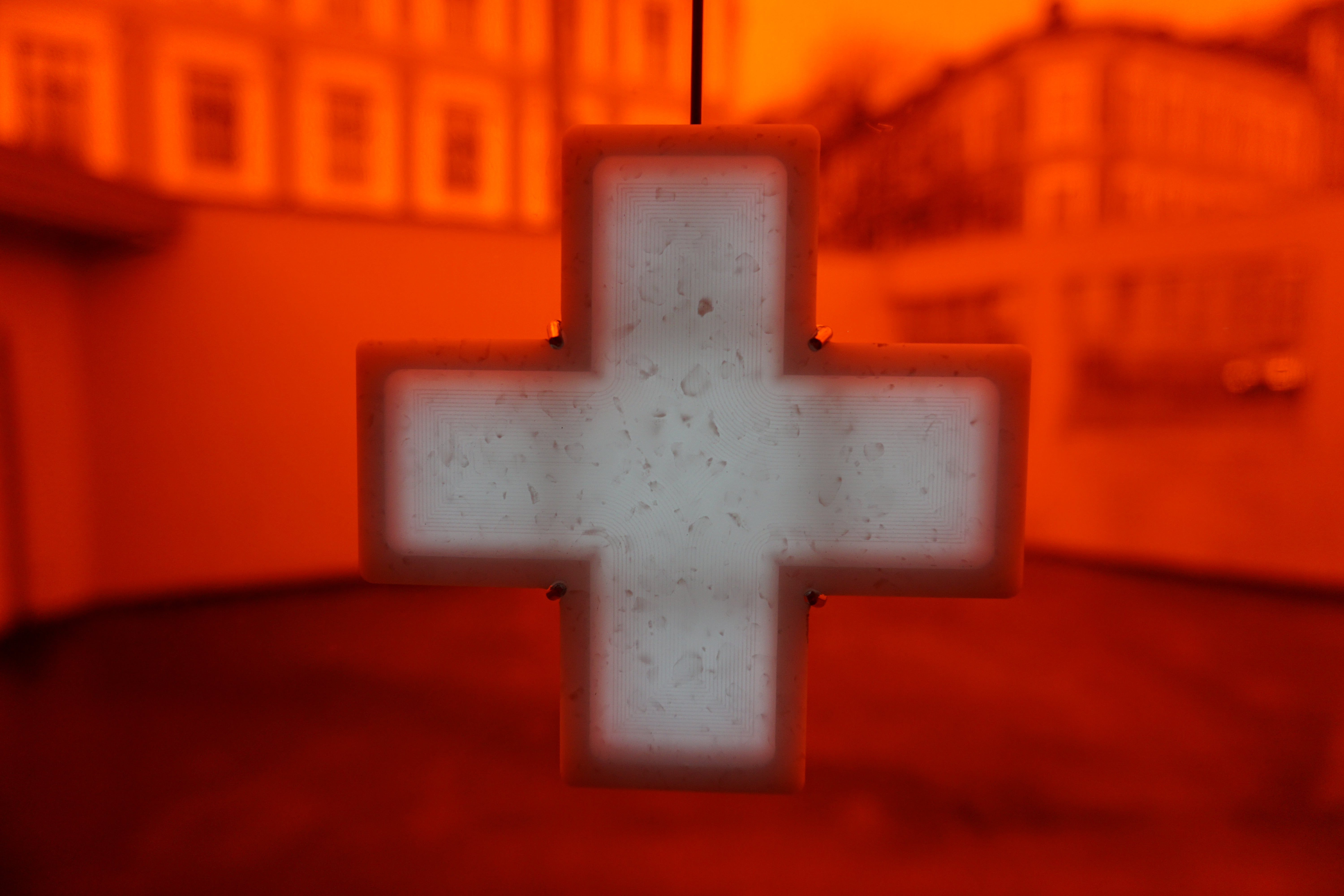
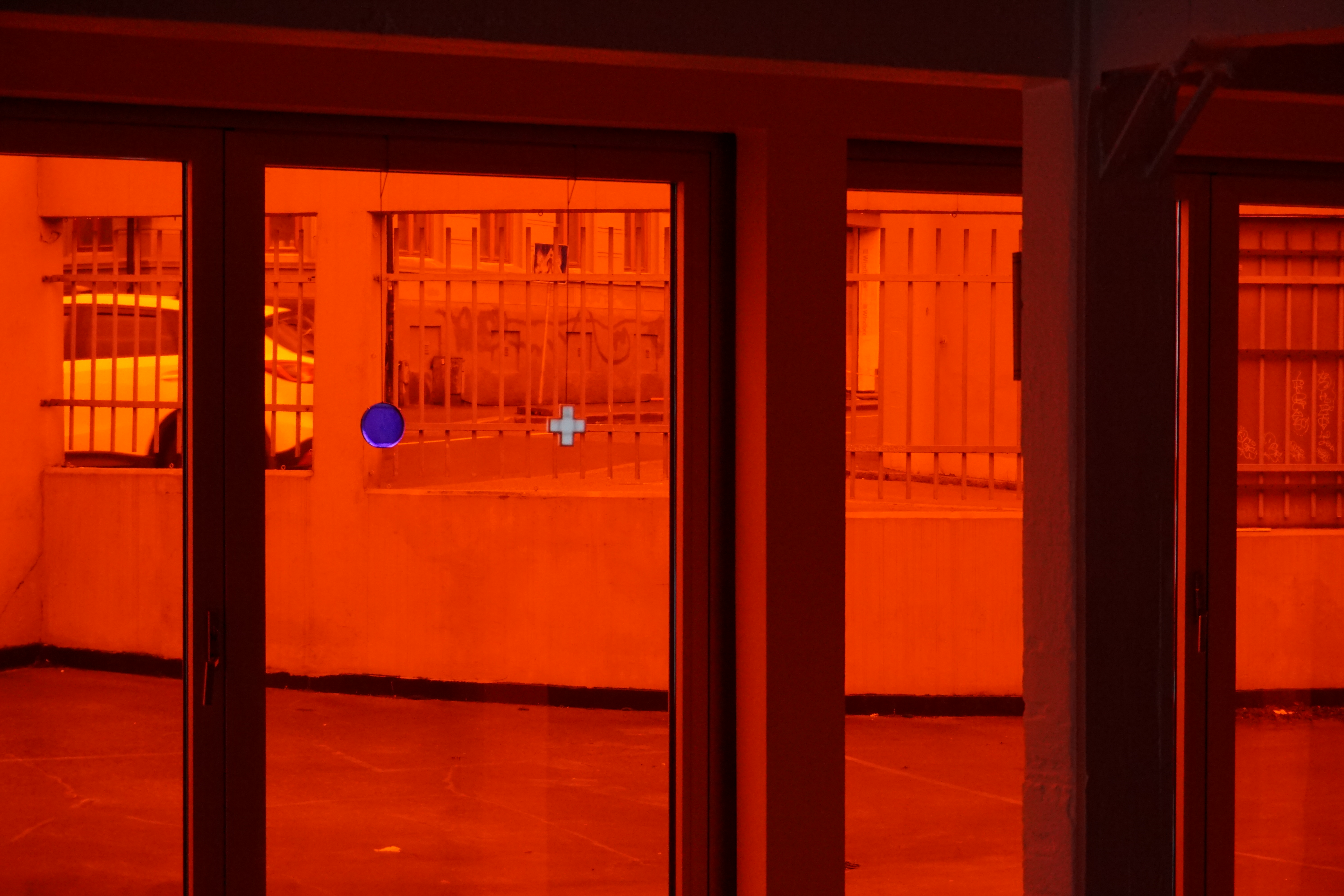
Objective Enactive is a sculptural installation on a sliding door. The installation consists of two recognizable symbols: a point and a cross, made of artificial materials: hydrothermal quartz (amethyst) and the composite material Corian. Together, these two symbols form a well-known instrument for discovering one own`s blind spot (discus nervi optici). Through the installation, the viewer can choose to look at the city scene that unfolds on the outside or explore the tiny "empty hole", which is a small field with reduced peripheral information in our field of vision.
The light flows into the eye through the pupil and is refracted in the iris and the lens (lens crystallina) before it hits the retina. The retina is surrounded by light-sensitive proteins, photoreceptors, which send electrical impulses to the optic nerve. The impulses are sent via the optic nerve to the visual center of the brain, which processes, and further interprets the information. Inside the soft body of the eye, right where the optic nerve exits the retina, there is one small spot without photoreceptive cells. A "blind" spot. When the brain does not receive visual information, it fills in the information by retrieving it from the surrounding image. Thus, we are never aware of the existence of the blind spot in our daily lives. The blind spot is known as the inexplicable in the relationship between the conscious and the nonconscious, it illustrates the most prominent problem in science of the cognition of the human race: what do we register as objective truth? What is subjective knowledge and is it reliable?
In computer technology and machine learning, errors in the execution of a command are referred to as "non-performativity" or a "glitch". With this work we ask if it is possible to understand glitches as technological relatives of the blind spot of the human eye? If so, it is an argument that technology is an extension of ourselves, imitating and evolving from the biological organism and taking part in the meaning-making, as our companions? How will this change the way we perceive our surroundings through our many lenses (in our own eyes, in the smartphone`s camera lens and in other digital gadgets)?
With Objective Enactive, we propose to redefine the blind spot in our field of vision, to a biological glitch: a ubiquitous protest in our perception of the environment. By examining the sense of sight by activating the biological glitch inthe consciousness, we may move from being a passive observer and recipient, to participating in a world through enaction, where the experience of being a body in a space, in a city, will be crucial for our future.
As artists, we are engaged in the exhibition space as chairman and technician. We have taken this point of view seriously, when we were invited by Bull.Miletic to participate in the researchproject. Through artistic reflection, we have developed the installation Objective Enactive and are challenged in this context to look at our roles in artist-ecology.
Ghosts of the Past? (Un)Mapping Urban Iconography
In her presentation, Stephanie von Spreter will give insight into her research project that takes as its starting point a public monument in the vicinity of ROM for Art and Architecture. It is the statue of the Norwegian-born priest Hans Egede by sculptor Nicolai Marius Schiøll that was placed in front of Trinity Church in 1965. Egede was active as a priest and is credited with establishing the first mission in Greenland in the early eighteenth century and which to many also marks the beginning of Greenland’s colonization. Today Egede is seen as a controversial figure, worshipped on the one hand, and condemned on the other. This controversial debate can also be read through sculptural manifestations of his persona: a newly produced copy of Oslo’s Egede statue was inaugurated at Harstad parish in 2008 (the old one was restored and donated to Vågan parish), while two other Egede statues by Danish sculptor August Saabye, one in Nuuk and the other in Copenhagen, were sprayed with graffiti in June 2020 with the word “decolonize”. In the wake of the Black Lives Matter movement, this iconoclastic act finds its parallels in many parts of the world, with the call to take down monuments representing colonizers, slave traders and human rights abusers. But so far Oslo’s Egede statue has gone under the radar. In my research I attempt to find out why this is so. My hypothesis is that this monument, similar to many street and place names, today merely acts as an orientation marker in urban space. In reference to cultural historian Elizabeth Edwards, it has the status of “just-thereness” and is no longer consciously processed in relation to what it originally represents. It appears that it is neither perceived as relevant in the new regime of the digitalized urban space that filters what is (commercially) relevant for the user. Nor has it yet been “awakened” by a public that scrutinizes the ghosts of the past.
Everywhere is Now: A Cartography of Remote Daydreams
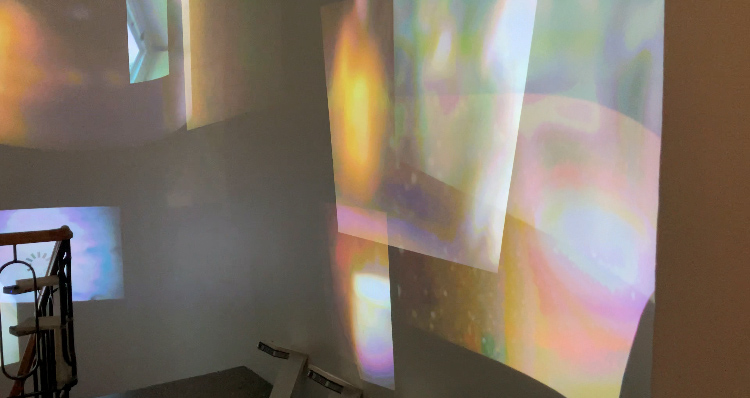
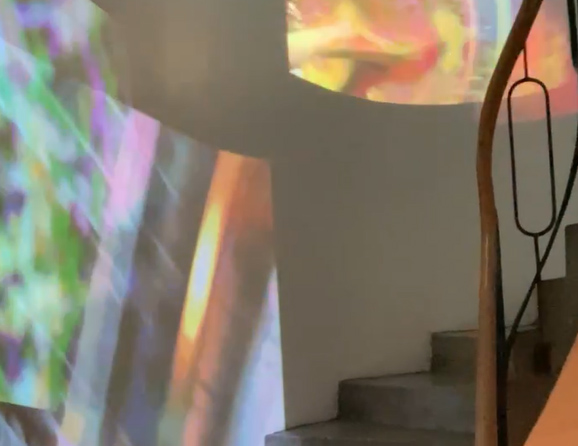
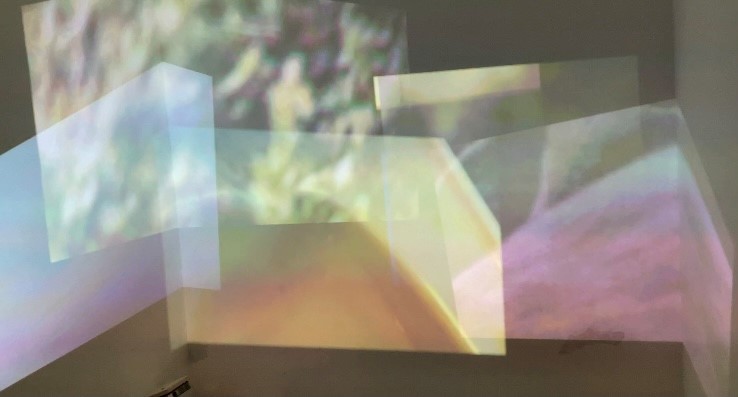
Can a smartphone camera operate on its own? How does a phone sense spatial conditions and urban environments? This project explores latent and imagined spatial narratives in video, images and screen shots from an incidental lifelogging archive captured by a smartphone that randomly documents my everyday spaces. Through investigating a ‘machine’ perspective on memory, emotion, and dream as vital components in perception of space, I question if there is such a thing as a transsubjective, or even cyborgian, digital topophilia (a strong sense of place or love for peculiar spaces).
In search of the algorithm of daydreams and sense of self and place in a networked and hybrid reality, the project discusses simultaneousness, crowd sourced and digitally constructed memories, quantified data and machine learning. An important question in my artistic research is how the surveillance technology and AI functions integrated into the everyday smart-devices that surrounds us intermingles with – and possibly even co-develops our spatial episodic memories, and such also our future spatial perception. Not to mention our existential ideas of identity and subjectivity.
The work consists of a spatial multimedia installation. 20 simultaneous projections are used to explore images and video material from the life-log archive as spaces on the threshold between the physical, the digital and the imagined. Based on the idea that a space always is experienced simultaneously in its reality, and in its virtuality, and that the individual's subjective spatial experience is formed in a cycle where every previous spatial experience, encounter or memory become active building stones in our future perceiving or imagining of new spaces, the work is intended as a kind of serendipity machine. In the projections' continuously changing overlap, new dreamlike spatialities constantly emerge in an eternal exchange between the spatial universe of the "sensing" smartphone and 'my' spatial preferences.
In realizing the installation, Kjersti has worked closely with Nicolai Fontain






